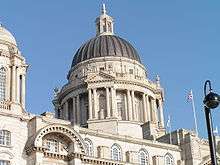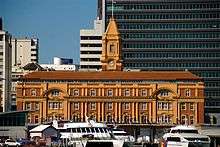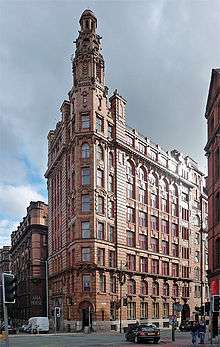Edwardian Baroque architecture



Edwardian Baroque is the Neo-Baroque architectural style of many public buildings built in the British Empire during the Edwardian era (1901–1910).
Description
The characteristic features of the Edwardian Baroque style were drawn from two main sources: the architecture of France during the 18th century and that of Sir Christopher Wren in England during the 17th—part of the English Baroque. Sir Edwin Lutyens was a major exponent, designing many commercial buildings in what he termed 'the Grand Style' during the later 1910s and 1920s. This period of British architectural history is considered a particularly retrospective one, since it is contemporary with Art Nouveau.
Typical details of Edwardian Baroque architecture include extensive rustication, usually more extreme at ground level, often running into and exaggerating the voussoirs of arched openings (derived from French models); domed corner rooftop pavilions and a central taller tower-like element creating a lively rooftop silhouette; revived Italian Baroque elements such as exaggerated keystones, segmental arched pediments, columns with engaged blocks, attached block-like rustication to window surrounds; colonnades of (sometimes paired) columns in the Ionic order and domed towers modelled closely on Wren's for the Royal Naval College in Greenwich. Some Edwardian Baroque buildings include details from other sources, such as the Dutch gables of Norman Shaw's Piccadilly Hotel in London.
Notable Edwardian Baroque buildings


- United Kingdom
- Admiralty Arch, London (1912)
- Albert Hall, Manchester (1910)
- Albert Hall, Nottingham (1910)
- Ashton Memorial, Lancaster (1909)
- Asia House, Manchester (1909)
- Australia House, London (1918)
- Belfast City Hall, Belfast (1906)
- Bridgewater House, Manchester (1912)
- Cardiff City Hall, Cardiff (1906)
- Central Criminal Court (Old Bailey), London (1907)
- County Hall, London (1922)
- Electric Cinema, London (1910)
- Hanover Building, Manchester (1909)
- Hove Library, Hove (1907–08)[1]
- India House, Manchester (1906)
- Laing Art Gallery, Newcastle upon Tyne (1904)
- Lancaster House, Manchester (1910)
- London Road Fire and Police Station, Manchester (1906)
- Lloyds Bank on King Street, Manchester by Charles Heathcote (1915)
- Manchester Victoria station, Manchester (1909)
- Marylebone station, London. (1899)
- Midland Bank head office building, London by Edwin Lutyens (1922)
- Mitchell Library, Glasgow, William B Whitie (1906–11)
- Municipal Technical Institute, a.k.a. Blackman Tech, Belfast (1906)[2]
- Nottingham railway station, Nottingham (1904)
- 163 North Street, Brighton (1904)[3]
- Ralli Hall, Hove (1913)[4]
- South Shields Town Hall, South Shields (1910)
- St. James Buildings, Manchester (1912)
- Stockport Town Hall, Stockport (1908)
- War Office, London (1906)
- Westminster Central Hall, London (1912)
- Australia
- Lands Administration Building, Brisbane
- Queen Victoria Hospital, Melbourne (main pavilion, now Queen Victoria Women's Centre)
- Commonwealth Offices, Treasury Place, Melbourne
- Central railway station, Sydney
- Department of Education building, Sydney (1912)[5]
- General Post Office, Hobart
- Canada
- Post Office (now part of Sinclair Centre), Vancouver
- Sri Lanka
- Royal College, Colombo
- Hong Kong
- India
- Ripon Building, Chennai
- Chowringhee Mansions, Calcutta
- Rashtrapati Bhavan, New Delhi
- Malaysia
- City Hall, George Town, Penang (1903)
- Second floor extension to Town Hall, George Town, Penang (1903)
- Former Government Offices (now State Islamic Council building), George Town, Penang (1907)
- Federated Malay States railway station/Malayan Railways building (Wisma Kastam), George Town, Penang (1907)
- George Town Dispensary, George Town, Penang (1922)
- Ipoh Town Hall and former General Post Office, Ipoh, Perak (1916)
- Railway station in Ipoh, Perak (1917 to 1935)
- Former State Secretariat (State Library), Seremban, Negeri Sembilan (1912)
- New Zealand
- Auckland Town Hall, Auckland, New Zealand
- General Post Office (former), Auckland, New Zealand
- Auckland Ferry Terminal
- Old Public Trust Building, Wellington (1909)
- Singapore
- Victoria Memorial Hall (1905)
- Central Fire Station (1908)
- Saint Joseph's Institution (1900s, 1910s extensions)
See also
References
- ↑ Antram, Nicholas; Pevsner, Nikolaus (2013). Sussex: East with Brighton and Hove. The Buildings of England. London: Yale University Press. p. 247. ISBN 978-0-300-18473-0.
- ↑ http://www.belfastmet.ac.uk/about-us/history-of-the-college/
- ↑ Antram, Nicholas; Morrice, Richard (2008). Brighton and Hove. Pevsner Architectural Guides. London: Yale University Press. p. 165. ISBN 978-0-300-12661-7.
- ↑ Historic England. "Ralli Memorial Hall, walls and railings, Denmark Villas, Hove (Grade II) (1298671)". National Heritage List for England. Retrieved 6 March 2013.
- ↑ "Department of Education Building". NSW State Heritage Register. Office of Environment & Heritage, Government of New South Wales. 9 February 2015. Retrieved 30 December 2016.